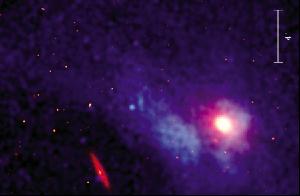
NASA/CXC/SAO/DSSElliptical galaxies: formation from the collapse of a gaseous cloud or from the merger with other galaxiesNASA/CXC/SAO/DSS
With rounded or oval shapes that look like a luminous ball, endowed essentially with old stars and almost devoid of cosmic gas and dust, the elliptical galaxies are the oldest to be known of. The first probably took shape a few hundreds of millions of years after the Big Bang, the primordial explosion that, according to the most accepted theory, created the Universe 14 billion years ago.
But there is still little scientific knowledge about the processes that originated this kind of galaxy, less abundant than those with the spiral format, like the Milky Way and Andromeda, or the irregular ones, like the Clouds of Magellan. After analyzing certain chemical characteristics of a sample of 29 elliptical galaxies located in the so-called local Universe, at a maximum distance of 300 million light years from the Earth, a group of Brazilian astrophysicists proposed a complex to explain the birth of elliptical galaxies.
By this idea, which was set out in an article published in October 2005 in the scientific magazine Astrophysical Journal Letters, objects of this kind can only be formed in two ways: by the slow capture of smaller galaxies or of equal size, in a process technically denominated Hierarchical Agglomeration; or by means of a very rapid implosion of a gas cloud, in a phenomenon known as Monolithic Dissipative Collapse.
As the mechanisms are not excludent, there is also a mixed scenario, in which the elliptical galaxies avail themselves of the two situations previously described to acquire their outlines. This third way, incidentally, may even be the predominant one. “Our observations support this hybrid scenario, in which both mechanisms contribute towards the formation of elliptical galaxies”, explains Marcio Maia, from the National Observatory, one of the astrophysicists involved in the studies.
If that is true, each galaxy can have a very particular life story, according to its characteristics, such as the greater or lesser presence of gas, the occurrence of mergers with other galaxies, and the environment in its neighborhood. There would be no general rule governing the birth of these celestial structures. When they confront the two theories, it could be said that the scientists are trying to discover whether the elliptical galaxies originated from other galaxies or from a large primordial cloud.
The first situation is compatible with the hypothesis of the Hierarchical Agglomeration, and the second with Monolithic Collapse. “This division of scenarios (about the formation of elliptical galaxies) is a bit artificial”, says Brazilian Cristina Chiapinni, from Observatoire Astronomique of the Université de Genève, in Switzerland, another author of the study. “I believe that the answer is between the two extremes, and that is apparently what we are seeing in the data we published.”
Metal in the galaxies
In the scientific article, the researchers used the technique of optical spectroscopy to measure the quantity of a chemical element, magnesium, along the longer axis of almost 30 elliptical galaxies. They opted to measure this parameter in order to test the ideas postulated for each one of the mechanisms.
According to the hypothesis of the Monolithic Collapse, the elliptical galaxies ought to show a greater concentration of metals in their central region – which would be populated by stars originating from gaseous matter enriched with metals and ejected by other stars and supernovas – than in their periphery. In technical terms, the astrophysicists say that, according to this mechanism, the galaxies ought to display a radial gradient of metallicity. A sort of birthmark left by their process of formation. This model also advocates the idea that the major part of the stars of the elliptical galaxies is very old, being generated in a short space of time in an abrupt way.
For the defenders of the Hierarchical Mechanism, which is also used to explain the origin of spiral and irregular galaxies, radial variation in the abundance of certain chemical elements in elliptical galaxies ought not to exist. And the reason for its nonoccurrence would be easy to understand: the galaxies of this kind originated at the junction of various smaller galaxies, and, during the process of fusion, the rich stars and the poor stars in chemical elements would end up blending, and the radial gradient of metallicity would disappear.
In this case, the process of birth of an elliptical galaxy would be slower and more gradual, and an addition of matter could occur in several stages of their lives. With the calculations and observations done, the final results pointed to a complex and nuanced picture: one third of the galaxies studied appeared to have been formed by the merger of smaller galaxies, one third by the Monolithic Collapse mechanism, and one third by both processes. “We want to double the size of our sample of galaxies analyzed for us to have more data about this question”, explains Maia.
Other parameters that may provide clues about the origin of these big agglomerations of stars have to be incorporated into the new studies. “The theme is very interesting, it is effervescing and is still pending”, comments astronomer Ricardo Ogando, who is finishing his doctoral thesis on the process of birth of the elliptical galaxies at the Physics Institute of the Federal University of Rio de Janeiro (UFRJ). “We have the possibility of making a contribution of impact and of putting in some more pieces of this jigsaw puzzle.”
Republish